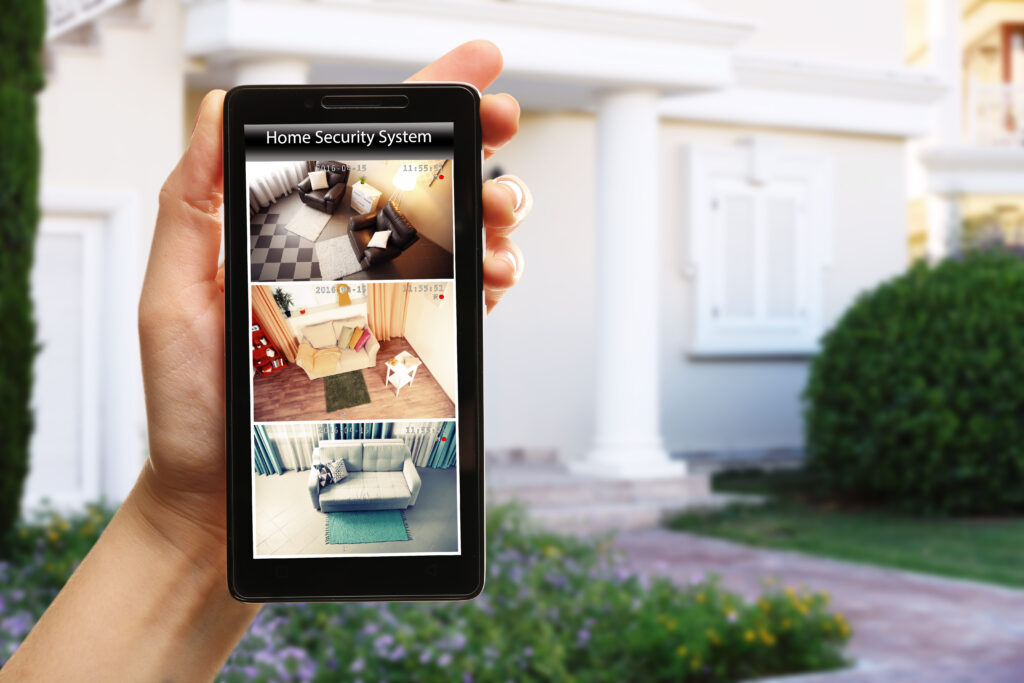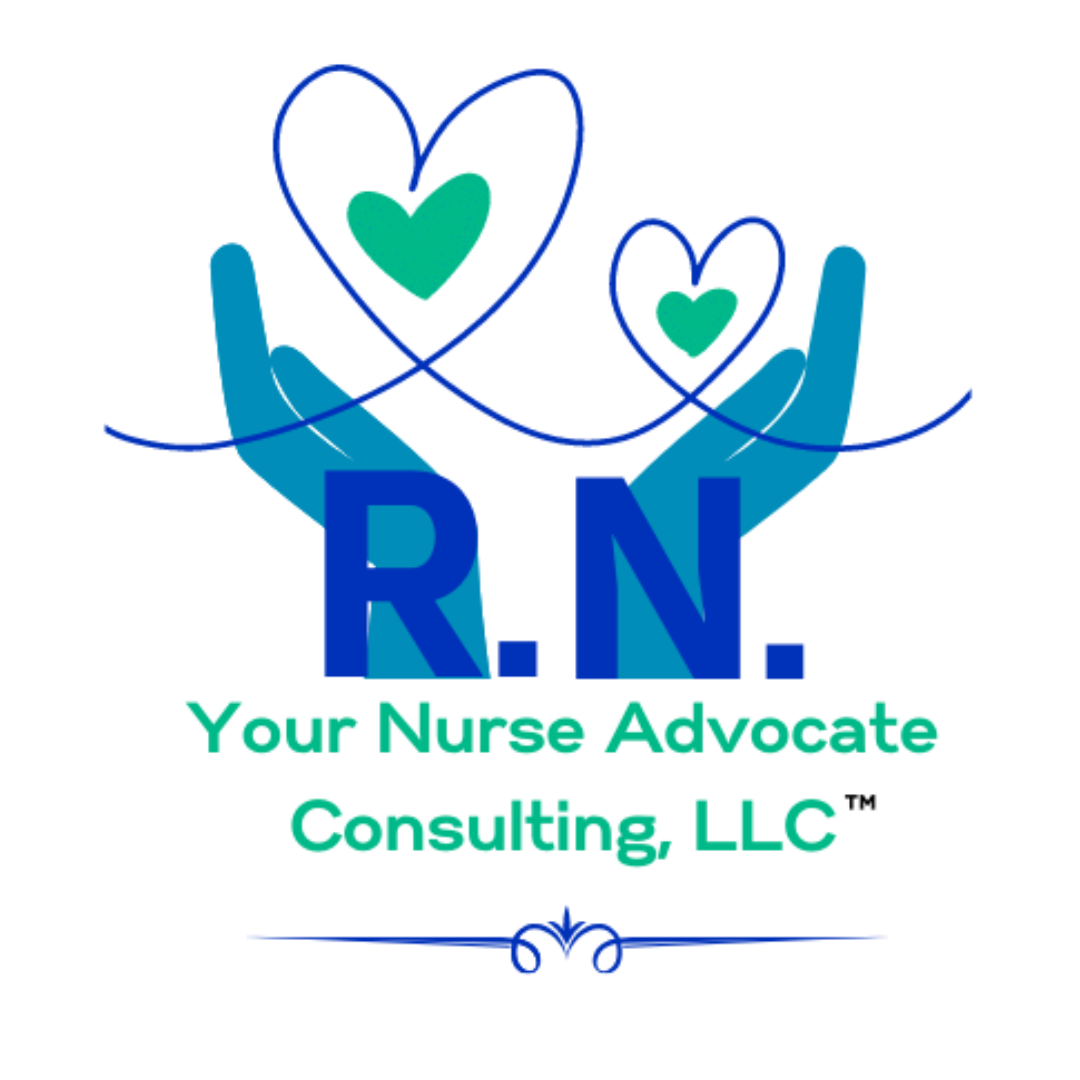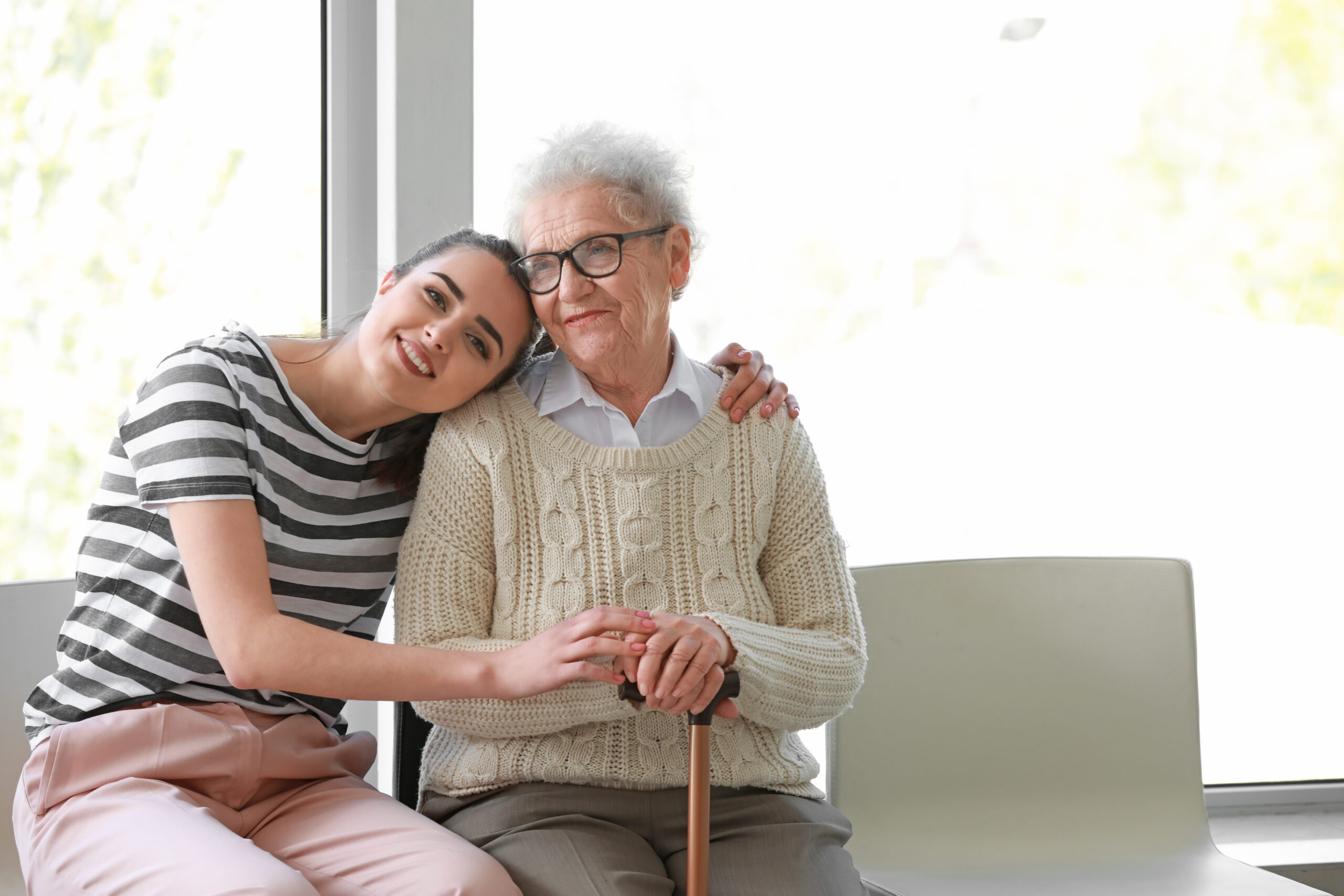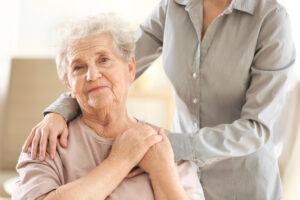“Aging in Place” is a term that signifies the desire of many seniors to live independently, safely, and comfortably, regardless of age, income, or ability level. Aging in place has been significantly supported by an array of innovative technologies designed to enhance the daily lives of seniors and their caregivers.
With advancements in technology, this dream is increasingly becoming a tangible reality for many seniors and their families. In this blog post, we’ll explore how innovative technologies, from smart home devices to telehealth services and wearable health monitors, are enhancing the daily lives of seniors, allowing them to maintain their independence while ensuring safety and well-being.

The Role of Smart Home Devices Impacting Aging in Place
Smart home technology has revolutionized the way we live, offering unprecedented convenience and security, especially for seniors. These devices can control lighting, temperature, and security systems with simple voice commands or through a smartphone app.
What monitors and video tools we used for our babies and children we can now help make our aging loved ones safe at home as well.
Imagine living in a home that responds to your needs without you having to lift a finger. For example, a fictitious Mrs. Johnson, an 80-year-old who cherishes her independence, smart home devices have transformed her living space into a haven of comfort and security. With simple voice commands, she can adjust lighting, control the temperature, and secure her home. This technology not only makes her daily routines more manageable but also provides her family with peace of mind, knowing that she is living in a safer environment.
The challenge for many seniors will be using the technology. This is a great way for grandkids to interact with their grandparents and help to teach them how to use the technology that can help keep them in their home for as long as safely possible.
Here are some examples:
ECHO 8 has voice controlled phone commands. You don’t have to find the phone to make a call.
Geo-fencing uses GPS to initiate a “safe zone” around your home and outside. If a loved one would go outside the “Safe Zone” they would get an alert via an app on their smart phone.
Smart door locks with code entry so losing keys is no longer an issue.
Automated lighting so the lights can turn on before entering a room.
Motion detectors in the home can alert family if unusual activity is noted.
We have included some more details in the resource section at the end of the blog post.

Phone Apps: A Lifeline in Your Pocket
Smartphone apps or smart watches are designed for senior care and offer a suite of features aimed at improving health management and communication. They serve as an essential tool for medication reminders, ensuring seniors take their prescriptions on time. Emergency call features provide a quick way for seniors to alert family or caregivers in case of an urgent situation. With health tracking capabilities, these apps monitor vital signs and progress, giving both seniors and their loved ones a comprehensive view of their health status. The connectivity feature keeps families and caregivers updated, fostering a supportive network that can respond promptly to the senior’s needs.
Some of the most popular are:
Face-Time on an iPhone or Skype
Lyft and Uber
Grandpad
Luminosity: We have talked about this one before. It is an app with mind games to help keep our aging adults minds sharp.
Abridge is an app that can record the conversation with the doctor. This can help your aging loved one remember what the instructions are or what the doctor said at their appointment. This app is free and available on both iPhone and Android.
NextDoor is a free social media app that allows users to communicate with people who live in their neighborhoods. Users can post messages seeking help from their neighbors or offering to pay for various services, including lawn care or home repairs. Can be used on both iPhone and Android.
Automated Medication Dispensers: Forgetfulness No More
Automated medication dispensers have revolutionized the way seniors manage their medication schedules. These devices dispense the right dose at the right time, significantly reducing the risk of missed or incorrect doses. For caregivers and family members, the ability to remotely monitor medication adherence brings immense peace of mind. This technology supports seniors in maintaining their independence while ensuring their health and safety.

https://stock.adobe.com/contributor/208188599/amazing-studio?load_type=author&prev_url=detail
Life Alert with Fall Detection: Immediate Help, When Needed Most
The fear of falling and not being able to get help is a significant concern for many seniors living alone. To age in place successfully, Life Alert systems with fall detection technology address this concern head-on. These wearable devices automatically detect falls and signal an emergency response center, ensuring that help is on the way, even if the senior cannot press the button themselves. This immediate response system can be the difference between a minor incident and a life-threatening situation, giving seniors the confidence to live independently.
Check with the life alert companies in your area and see how the response system works with the fall detection. We have had clients that are concerned with unnecessary calls to 911 and breaking into the home when a key is not available. Having a coded lock for entry into the house could reduce the risk here and the medical alert company could have the code.
Home Video Surveillance: Eyes That Care
The integration of home video surveillance in senior care offers a new level of safety and reassurance. This technology allows family members and caregivers to remotely monitor the senior’s environment, ensuring they are safe and well. Motion detection and night vision capabilities provide clear surveillance at all times, while two-way audio communication enables real-time interaction. Home video surveillance acts as an extension of the caregiver’s eyes and ears, providing a protective watch over seniors from afar.
Real-World Impact
The real-world applications of these technologies are as diverse as they are inspiring:
- Mrs. Smith can now enjoy a newfound sense of independence and adherence to her medication schedule, thanks to a phone app that keeps her and her daughter connected and informed. A unit by HERO Medication dispenser can automatically alarm and open the drawer to take the medications and can send an alert via a phone app to a caregiver to let them know if you did not take your medications.
- A previous client of ours, Mrs. D suffered from Alzheimer’s Disease. We used every device to keep her safe in the home as she wandered, ate and drank things she shouldn’t, she would get up in the middle of the night and try to get out of the windows. Using technology and different types of safety devices we were able to keep Mrs. D home as her husband wished. We eventually had to add caregivers in the home but we were able to keep her home with Mr. D.
These stories highlight just a fraction of the positive outcomes possible when technology and compassionate care come together. By integrating these tools into the care plan for seniors, we can address the challenges of aging with innovative solutions that promote independence, safety, and connectedness.
For those caring for loved ones or navigating the complexities of aging, these technologies offer more than just convenience—they provide a bridge to a life filled with dignity, security, and well-being.
Telehealth Services: Bringing Healthcare Home
Telehealth services have emerged as a vital tool in the healthcare sector, particularly for seniors. This technology enables regular check-ins with healthcare providers without leaving the house, which is invaluable for those with mobility issues or chronic health conditions. This is a major concern for those frail aging adults that would like to continue to age in place.
Some of the benefits of telehealth and our seniors include:
- No need for travel or arranging transportation often interrupting a family member’s work/
- Seniors living in a rural area can get access to specialists they may have to travel long distances to see.
- Allows our seniors to age in place and still receive medical care often which is more accessible and quicker with telehealth.
Since the pandemic telehealth has accelerated and refined its use. We used to wheel computers into a patient’s room and set them up with a doctor. Today providers like Dr. James Williams uses telehealth for his entire practice visiting seniors with the use of a smart cell phone and things like a Bluetooth stethoscope. We will share Dr Williams Senior Care Summit Video here where he discusses the use of telehealth with seniors as well as overcoming the challenges of technology.
Wearable Health Monitors: Empowering Seniors
Wearable technology has also made strides in supporting seniors’ health and well-being. Devices like health monitoring smartwatches track vital signs, activity levels, and even sleep patterns, offering insights into one’s health status. George, a retired veteran, credits his smartwatch with potentially saving his life. It detected an irregular heart rate, prompting him to seek immediate medical attention. Stories like George’s highlight the empowering nature of wearable tech, allowing seniors to take control of their health and act swiftly when issues arise.
Wearable health technology is another glimpse of hope for seniors striving to maintain their independence. George, a retired veteran, wears a smartwatch that continuously monitors his health metrics, such as heart rate and sleep quality. When his watch detected an irregular heartbeat, it prompted him to seek immediate medical attention, which was crucial in preventing a potential health emergency. Such wearable devices are invaluable tools for seniors, offering real-time health insights and fostering a proactive approach to their well-being.
The down side once again, is the aging adult using the technology. If your aging loved one is opposed to using technology, that will limit the impact. Technology would then be limited to what the caregiver’s can use. Neither my mom or my mother-in-law used a computer, smart phone, or other device requiring the use of technology nor did they want anything to do with them! It does make it more difficult.
Besides these wearable health monitors clinics also have the technology to do home monitoring for Congestive Heart Failure, Chronic Obstructive Pulmonary Disease, hypertension, and diabetes. Ask your clinic regarding whether or not they have these programs available.
Overcoming Barriers to Technology Adoption
Despite these technological advances, some seniors and caregivers may feel overwhelmed or skeptical about integrating them into their lives. Concerns about complexity, privacy, and cost are common, but with the right guidance and support, these barriers can be overcome. Here are a few tips for successful technology adoption:
- Start with simple devices and gradually introduce more advanced options. We did get both of our moms to use a cell phone.
- Seek out user-friendly technologies designed with seniors in mind.
- Ensure privacy settings are properly configured to safeguard personal information.
While the benefits of these technologies are vast, adopting them can come with challenges. Concerns over privacy, the complexity of technology, and accessibility can deter seniors from taking the plunge. Addressing these concerns through education, support from caregivers, and choosing user-friendly products can pave the way for a smooth transition. Encouragingly, many companies are now designing tech products with seniors in mind, focusing on simplicity and ease of use.

Conclusion
The landscape of aging is changing, with technology playing a pivotal role in shaping a future where seniors can enjoy the comfort and security of their homes for as long as possible. For seniors and caregivers willing to explore the possibilities, the integration of smart home devices, telehealth services, and wearable health monitors can significantly enhance quality of life and independence.
We encourage you to consider these solutions as part of your or your loved one’s aging in place strategy. If you’re looking for more information or need personalized advice, Your Nurse Advocate Consulting is here to help guide you through the options and ensure you make the best choices for your situation.
The digital age presents a myriad of opportunities for seniors to live safely and comfortably at home. From smart home devices to telehealth services and wearable health monitors, these technologies offer practical solutions to the challenges of aging. We encourage seniors and caregivers to explore these options and consider how they can be incorporated into their daily lives.
At Your Nurse Advocate Consulting, we are dedicated to supporting you on this journey. If you’re looking for personalized advice or further information on how to make the most of these innovative technologies, don’t hesitate to reach out. Together, we can harness the power of technology to make aging in place not just a possibility, but a reality.
For those interested in further exploring the wonders of senior technologies, please consult our additional resources and references. Your path to a more empowered and independent life starts here.
References and Additional Resources
For those interested in further exploring the world of senior technologies and aging in place, additional resources and studies are available. These can provide deeper insights into the benefits and practicalities of integrating technology into daily life for seniors.
By understanding and leveraging these innovative tools, seniors and their caregivers can create a supportive and safe environment that fosters independence and well-being for years to come.
Thanks for stopping by and spending a few minutes with us here today. We hope some of these strategies will be helpful for you. Please check the resources below for more ideas, solutions and explanations. We share just a few with you here today.
Take care and see you back here soon,
Pam and Linda
Your Nurse Advocates
“Compassionate Care for Aging Adults, Peace of Mind for the Adult Children.”
Your Nurse Advocate Consulting, LLC
Resources:
https://seniorsafetyadvice.com/best-phone-apps-for-seniors






